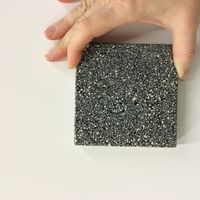LOL--the best ever! Once again, you have outdone yourselves in the April 1 issue!
April Fools
USGBC Embraces Legal Marijuana
April 1, 2019
Working session of the LEED Materials Technical Advisory Group, taken at the 2018 Living Future unConference in Portland, Oregon.
Responding to marijuana legalization in Canada and multiple U.S. states, U.S. Green Building Council (USGBC) has announced numerous changes to ensure the LEED standard stays current with changing demographics among cannabis users.
“LEED is constantly evolving, and we are proud to remain ahead of the curve on this major shift in building occupant behavior. We’ve always recognized the unique needs of the [marijuana-using] community, starting back in LEED NC 1.0 with the Stairwell Roof Access credit. Next came the Dimmable Lighting credit in LEED 2.2, which led of course to an entire Schools rating system in LEED 2009,” said USGBC Senior Vice President Brendan Owens.
Owens noted, however, that the current system is “half-baked, and a bit of a hash,” and that the time has come for a more comprehensive approach.
A new high for LEED
The newest LEED iteration, LEED v4.20, includes a sheaf of new prerequisites, making cannabis compliance no longer optional.
“Speaking bluntly, I think it’s downright negligent nowadays to build without taking marijuana use into account,” said LEED Fellow and steering committee member Marcus Sheffer. “Given the impacts on indoor air quality, water use, healthcare, and… a building’s overall vibe, it’s high time we put the ‘W’ into LEED.”
New prerequisites in LEED v4.20
Isolated ventilation zones with manual override
Formerly Schools-NCv4 EQc10, this new requirement is more widely known as “the hotboxing credit,” giving occupants the ability to temporarily disable ventilation in an enclosed space. According to the official credit language, these designated spaces must be fully separate from the main ventilation system to keep the rest of the building from “getting skunky.”
Indoor micro-growery zones
This prerequisite straddles the Water Efficiency and Energy categories, requiring buildings to provide plumbed, south-facing spaces for hydroponic cannabis cultivation.
According to the unusually informal and often rambling credit language, “[The LEED authors] got into a long debate about whether it was cool to use 1500W HID grow-lights like my roommate and I did back at RISD as long as we offset the power use with equivalent onsite PV, but in the end we weren’t that jazzed about bogarting that much power when we could just tap into good ol’ Mama Soleil.”
(There is also a related 1-point credit, “Enhanced bongwater management,” which captures used water pipe fluid for reuse in hydroponic reservoirs or outdoor landscaping.)
Food source proximity
In this prerequisite, occupants must have unrestricted access to food, with buildings meeting at least one of the following criteria:
- All occupants have 24-hour access to a kitchen (1 point).
- Occupants have 24-hour access to their mother’s or grandmother’s kitchen (2 points)
- Building is within ¼-mile (400 meters) walking distance of a grocery store, drugstore, or mini-mart (2 points).
- Building is within delivery range of a pizzeria or Chinese restaurant, or in an area served by Grubhub or Uber Eats (3 points).
- Building is within ¼-mile (400 meters) walking distance of two or more late-night food trucks (3 points) or a Girl Scout cookie kiosk (4 points).
An enhanced LEED Dynamic Plaque
The LEED Dynamic Plaque, redesigned for LEED v4.20, has proven exceptionally popular among building occupants of all ages.
LEED v4.20 also introduces a new LEED Dynamic Plaque, and projects can earn up to 5 points for each additional plaque displayed. The new plaque, which was jointly reimagined at last year’s USGBC Leadership Retreat in Boulder, Colorado, features a vibrant color scheme with interactive controls to promote occupant engagement.
In a pilot program, the new plaques were installed at a suburban high school, a Silicon Valley startup, and two nursing homes, and according to Owens the response has been highly enthusiastic.
“People really love these plaques! Nursing homes in particular … they’re installing them in lounge areas, where residents bring their vape pens and just stare at it for hours. Which is actually great for staff members, who up till now had to listen to Fox News and old Matlock episodes at top volume.”
Other rating systems respond
While USGBC congratulates itself for taking the early lead on cannabis, representatives from other rating systems maintain they’ve long since taken marijuana use into account.
It is widely agreed, for example, that the Passive House standard was inspired by super-insulated, passive solar houses built in North America in the 1970s by “a bunch of potheads” (Wolfgang Feist, 2009). “What could be more suitable for marijuana users than a well-ventilated home with large south-facing windows and no dangerous sources of combustion? Even the process of building a Passive House is suited to such people. The act of meticulously taping every last gap in the envelope becomes an entrancing labor of love to the cannabis user.”
In 2016, however, Dr. Feist noted that the difficulty of including a fireplace in a Passive House is “an unfortunate shortcoming” of the standard, since watching the flickering flames can be “quite mesmerizing.”
Jason McLennan, founder of the Living Building Challenge, insists that “[marijuana use] is baked into LBC’s very core.”
“Could we have made it any more obvious? The system has ‘petals’ for crying out loud!” He added that the original LBC draft referred to red-list materials as “seeds and stems.”
Looking ahead
Owens anticipates enthusiastic market response to LEED v4.20. “A lot of projects have already enrolled in the new version, including a top-secret Elon Musk venture as well as a Snoop Dogg-branded boutique hotel. We’ve even had budding interest from the Department of Defense, which is pretty astonishing considering the federal laws against cannabis, but this just tells you how much the tide is turning.”
Owens added, with a slow exhale, “There’s no question that the prohibition rulebook is going up in smoke, and we’re just glad to be part of that spark.”
Comments
Thank you for your
Thank you for your contributions this day, every year.
LEEDv2.0
Hilarious! Very wise to be close to a Girl Scout cookie kiosk. No half-baked cookies.
USGBC and Mary Jane
So Andrea, we find out who Adrenal Omen is, eh? Very cute...
This entire article was so well done, as usual.
I guess next year you'll have to add hemp in there somewhere.
And Brendon, I never would have figured you to have such a great sense of the ridiculous and sublime.
It's going to be tough waiting for a whole year for the next one!










Add new comment
To post a comment, you need to register for a BuildingGreen Basic membership (free) or login to your existing profile.